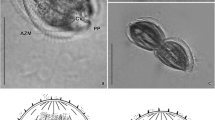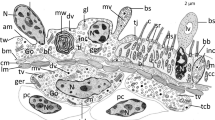Abstract
The fully developed flame bulb ofPhilopthalmus exhibits the structure characteristic of Trematoda and Monogenea: external and internal ribs forming a weir, external and internal leptotriches, and two longitudinal cytoplasmic cords connected by a septate junction. The proximal canal has a septate junction and surface lamellae. In developing cercariae, perikarya of terminal and proximal canal cells are close together, and sheetlike outgrowths of the terminal cell are externall surrounded by cytoplasm of the proximal canal cell containing a septate junction. Internal outgrowths and external cytoplasm are connected by many “membranes”, i.e. desmosome-like structures. Internal sheets break up into internal ribs, and the external cytoplasm breaks up into external ribs, external and internal ribs connected by the filtration “membrane”. The developing distal excretory duct possesses a septate junction and many branching and looping lamellae. A comparison ofPhilopthalmus with the cestodeAustramphilina elongata, the only other platyhelminth species in which the development of the protonephridia has been studied at the ultrastructural level, revealed that the two species differ in the presence and absence, respectively, of a septate junction in the flame bulb at an early stage of development.
Similar content being viewed by others
References
Ebrahimzadeh A, Kraft M (1971) Ultrastrukturelle Untersuchungen zur Anatomic der Cercarien vonSchistosoma mansoni: II. Das Exkretionssystem. Z Parasitenkd 36:265–290
Ehlers U (1985) Das phylogenetische System der Platyhelminthes. G. Fischer, Stuttgart New York
Rees GF (1977) The development of the fail and the excretory system in the cercaria ofCryptocotyle lingua (Creplin) [Digenea: Heterophyidae] fromLittorina littorea (L.). Proc R Soc Lond [Biol] 195:425–452
Rohde K (1990) Phylogeny of Platyhelminthes, with special reference to parasitic groups. Int J Parasitol 20:979–1007
Rohde K (1991). The evolution of protonephridia of the Platyhelminthes. Hydrobiologia 227:315–321
Rohde K, Watson NA (1988) Development of the protonephridia ofAustramphilina elongata. Parasitol Res 74:255–261
Rohde K, Watson NA, Roubal FR (1992) Ultrastructure of the protonephridial system ofAnoplodiscus cirrusspiralis (Monogenea, Monopisthocotylea). Int J Parasitol (in press)
Author information
Authors and Affiliations
Additional information
Financially supported by the Australian Research Council and the University of New England
Rights and permissions
About this article
Cite this article
Rohde, K., Watson, N.A. Ultrastructure of the developing protonephridial system of the cercaria ofPhilophthalmus sp. (Trematoda, Digenea). Parasitol Res 78, 368–375 (1992). https://doi.org/10.1007/BF00931690
Accepted:
Issue Date:
DOI: https://doi.org/10.1007/BF00931690




